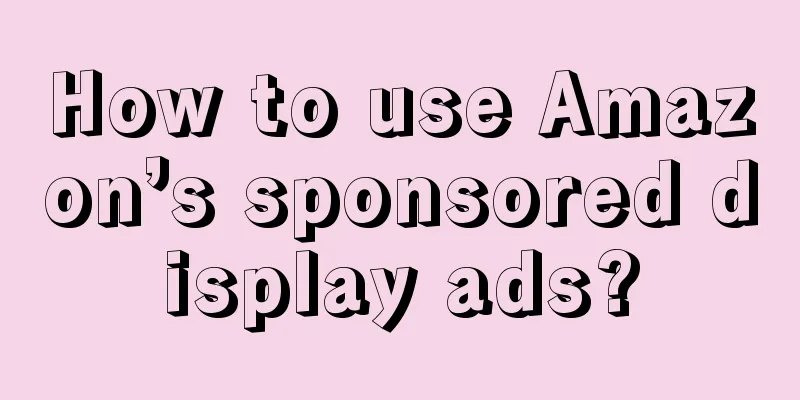How to use Amazon’s sponsored display ads?

|
Amazon platform has a variety of advertising products, which are convenient for sellers to use flexibly. Sponsored Display Ads (formerly called Product Display Ads) are a remarketing ad offered by Amazon that displays advertised products to people who have viewed your product or similar products. Sponsored Display ads are cost-per-click (CPC) and can increase your product’s exposure and even position your competitor’s products.
Sponsored Product Ads and Sponsored Brand Ads both use keywords to target audiences, while Sponsored Display Ads use Amazon to target audiences based on consumer shopping behavior. After viewing your product or similar products, these consumers are likely to purchase your product. The advantages of sponsored display ads mainly include the following:
Increase your product visibility Driving traffic to product pages Place ads under competitor products Increase exposure of new products Since sponsored display ads do not appear on Amazon’s search results pages, the ads tend to have lower conversion rates. But because of this, this ad is not as competitive as Sponsored Product Ads and Sponsored Brand Ads, and the overall ad spend is lower than the account average. With sponsored display ads, you can display ads on your competitors’ product pages. Note that your ads must match your competitors’ products in order to have a chance to get clicks and sales.
Sponsored display ads appear below the purchase options, in addition to:
Product details pages on desktop and mobile Comments page Top position of Offer Listing Pages
Note: There are some differences between the two display ads above. The one on the right is a product display ad, which includes a logo and a custom title. Most product display ads have now been replaced by sponsored display ads, which cannot be customized and can only display your product images, titles, prices, and reviews. Amazon stopped product display ads in 2018, but you can still see a few survivors from time to time.
Creating a Sponsored Display ad is easy and only takes a few minutes: Step 1: Enter Campaign Manager Step 2: Click Create Ad Step 3: You will be prompted to choose what type of ad you want to create. Select Sponsored Display Ads.
Step 4: Enter ASIN or product name to select product Step 5: After selecting your ad product, set your bid Step 6: Set your campaign name, budget, and duration According to Amazon, the minimum daily budget for advertising is $1, and the cost per click is $0.22. Amazon recommends that sellers run ads for a month and evaluate the overall results. Step 7: Preview your ad and submit your campaign and you are done.
It is recommended that sellers first create an ad for one ASIN, then optimize ACOS to reach the target they set, and then create more ad campaigns. The safest approach is to choose your best-selling product and then highlight the features that are different from competing products. If sellers want to increase brand awareness and compete with competitors, they must use this ad. Compiled by ✎ Mary/ Statement: When reprinting this article, the title and original text must not be modified, and the source and original link must be retained. |
<<: [Class Started] The third TikTok zero-based practical class is now open for registration!
>>: Pinch your own philtrum! Amazon France may face a ban on sales of its products because...
Recommend
Mexico Christmas shopping trends: Amazon and Mercado are the top platforms
It is learned that recently, according to the &quo...
Do you know Dealnews?
text At present, the most popular off-site promoti...
This can lead to a store closure?! Amazon's new method of cracking down on fake orders is exposed!
focus on new What is the review mechanism?Ever si...
What is ZonPages? ZonPages Review
ZonPages provides sellers with various tools to pr...
What should I do if my account is deactivated after registration?
What should I do if my account is disabled after ...
What is Eagles Technology? Eagles Technology Review
Eagles Technology was established in 2015 and belo...
The differences between Pinduoduo and others: Temu is selling like crazy, Wish is selling itself
Under the pressure of continued high inflation in ...
FBA warehouse shipments were confiscated! Be careful when selling these products
News about an FBA warehouse broke out these two da...
What is Shoplazza? Shoplazza Review
SHOPLAZZA is a company that focuses on providing p...
What is the Benelux Office for Intellectual Property (BOIP)? Benelux Office for Intellectual Property (BOIP) Review
The Benelux Office for Intellectual Property (BOIP...
Masks! Free commission for 3 months! Just now, Amazon officially announced...
Recently, many Amazon sellers have been feeling pr...
Many countries have issued mandatory orders! Is there another window period for epidemic prevention products?
Let’s start today’s main text. ◆ ◆ ◆ ◆ I still va...
Amazon Newbies Must Read: Refined Practical Experience Operation Manual
Channel Operation Manual 1. Set sales targets 2. ...
What is Guaranteed Delivery? Guaranteed Delivery Review
Guaranteed Delivery is a feature of eBay that allo...
What is 3C certification? 3C certification review
3C certification is the abbreviation of China Comp...









